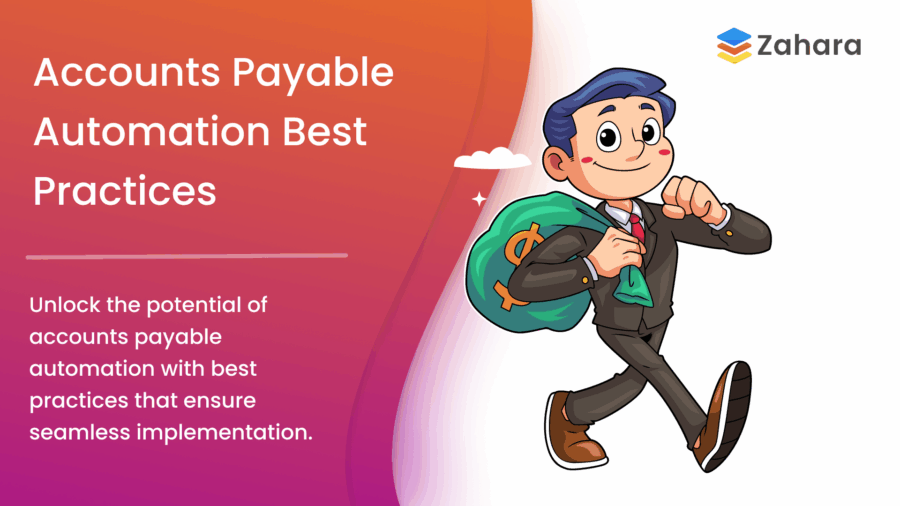We hear it all the time: businesses rushing into automation without getting their ducks in a row. The results just create a new set of problems instead of working on the ones they set out to untangle. Automation will only reap rewards if done right.
Table of Contents
In this article we’ll look at accounts payable automation best practices and the common mistakes you need to avoid when rolling out an accounts payable automation job.
Understanding accounts payable automation
If you’re going to automate, you best know the basics. With that in mind, here’s a short explainer on the more salient points.
In short, accounts payable (AP) automation refers to the use of technology to streamline and digitise the payables end of a company’s finance operations.
Traditionally, accounts payable processes have been manual and paper-intensive, involving physical invoices, data entry, approvals, check writing and a lot of man hours.
With automation the whole process is overhauled. Using software like Zahara, you can now digitise and streamline AP from top to bottom. Replacing the manual steps with digital workflows improves accuracy, efficiency, and visibility, among other benefits we’ll get into below.
AP automation software captures invoice data digitally – often using OCR software (optical character recognition) – and uses AI to read the information. It then routes the data through predefined approval workflows. Once approved, payments can be scheduled and executed automatically, with just a few clicks.
This reduces the risk of human error, missed payments or fraud, and generally makes the process much smoother and simpler.
Try out the future of AP, register a Zahara trial for FREE.
Try Out ZaharaBenefits of AP Automation for Businesses
Facts: Automation leads to significantly quicker invoice-to-payment cycles.
Enterprises using digital payables platforms experience an 81% reduction in AP costs and 73% faster processing cycle times
A key benefit of AP automation is time saved. Your tired manual processes can take days to process an invoice, while automated systems process them in minutes. Control will be improved too: Approval workflows are a major part of automation and give management better oversight on spends.
Digital audit trails feed into this. If an errant employee has their hands in your piggy bank, their schemes will be stuffed by your approvers’ new oversight. Those same audit trails will show up leaks in your books, protecting you from fraud and showing past fraud up.
Additionally, real-time dashboards and reporting tools help your finance teams monitor cash flow, identify bottlenecks and make informed decisions about your finances.
Cost reduction is another major advantage. Automation cuts back paper use, postage, late fees and labour costs. Vendors also benefit from faster, more reliable payments, which can strengthen business relationships.
Ultimately, accounts payable automation is not just about speeding up invoice processing. It’s about transforming a back-office function into a strategic asset. By adopting AP automation, organisations gain control, reduce risk, and position themselves for scalable growth.

Martin Peirce
Founder and CEO
Key considerations before implementation
Automation can deliver significant benefits, but only if implemented with a clear understanding of current needs and limitations. Before diving into accounts payable automation, step back and carefully assess several key factors. When asked about accounts payable automation best practices, these are the questions we fire back:
What are the pain points in your current AP process?
Start with a thorough review of how your AP function currently operates. Identify bottlenecks, repetitive tasks, error-prone steps, and manual dependencies. In short, understand your pain points.
Knowing this guides your choice – and customisation of – an automation solution that solves real problems.
What are your budget and ROI expectations?
Implementing AP automation requires an upfront investment – not just in software, but in training and integration too.
Set a realistic budget and define what your ROI looks like. Consider cost savings from reduced processing time, fewer errors and improved vendor relationships.
But remember benefits don’t just come in cash form. If they don’t have to file invoice after invoice, your finance teams will have more time on their hands. What are they going to do with it?
-What integration requirements do you have?
Your automation software must integrate with your existing accounting system. Good AP automation software, like Zahara, will integrate with all major accounting programmes (QuickBooks, Xero, Sage etc.) but you also need to evaluate whether APIs, plugins or manual workarounds will be needed.
Ensure your IT team is involved in these discussions early on, they can be a major asset in dissecting these problems.
What are your security and compliance needs?
Handling financial data digitally requires risk management. Make sure your AP solution complies with relevant regulations (like Making Tax Digital for the UK, tax law, etc.), and look out for accreditations that prove the software you’re integrating is reliable.
To use Zahara as an example again, these would look like our Cyber Essentials Plus certification and a guarantee of regular security tests by third parties.
| Security Measure | Detail |
|---|---|
| Cyber Essentials Plus | Government-backed certification in the UK |
| Microsoft Azure | Secure, global cloud infrastructure |
| Encryption | Full encryption at rest and in transit |
| Two‑Factor Authentication | Adds an extra security layer for users |
| Annual Pen Tests | Regular external audits to uncover and fix vulnerabilities |
| High-Availability Backups | Mirrored storage with encrypted 15-minute backups |
Sources: Gov.co.uk/cyberessentialsplus, Microsoft, Acronis, Google Cloud
How is this going to change operations?
Automation will impact how your finance team works. How will you handle that? We often hear about internal resistance to change coming with automation. Have you considered roles for people who now have more time on their hands? Who will take on responsibility to approve payments?
Accounts payable automation best practices for a successful roll-out
Successfully implementing AP automation requires more than just picking out software. To unlock its full benefits you have to approach implementation the way a field marshal regards tactical maps: with a clear mind for strategy and steely eyes for deliberate action.
The following best practices are things we’ve learnt on the way, and should provide a practical, road-tested map to smooth roll-out and long-term success.
Set clear objectives from the start
Define what success looks like. Are you aiming to reduce invoice processing time by 50%? Improve early payment discount capture? Eliminate manual data entry and the errors that come with it? Are you trying to control spends with purchase order software?
Make your objectives specific and measurable. This ensures that your implementation stays focused and allows you to evaluate its success post-deployment. You can also align these objectives with broader business priorities such as cost control, supplier satisfaction or compliance.
Engage the right stakeholders early
Roll-out isn’t just about your finance department. Getting the whole crew on board is key to successful AP automation. Include brains from procurement, IT, compliance – even key vendor partners – into your decision making. Each stakeholder group brings valuable insight into how invoices are handled from purchase order to payment, and all of them will be affected by automation.
All-round collaboration helps identify potential integration issues, process gaps and user needs, before they become problems. It also gives stakeholders plenty of time to adjust to the idea of change.
Choose the right solution for your business
Not all AP automation software is created equal. When evaluating platforms, look for features that align with your business size, complexity and growth ambitions. Don’t forget to consider the external business environment either.
As for the specifics of the software, you’ll be looking for something that does:
- Optical character recognition (OCR) and AI-powered data capture
- Customisable approval workflows
- Integration with your existing ERP or accounting system
- Real-time reporting and analytics
- Cloud-based access with robust security
You want to know what you’re buying, so request demos. Quiz vendors about support and scalability. User reviews and endorsements will also make your decision more informed.
Prepare and cleanse your data
Poor data quality can sabotage even the best AP automation platform. Before going live scrub up your vendor database: remove duplicates, ensure accurate banking details, standardise naming conventions, verify tax information.
Establish clear invoice requirements with your suppliers as soon as possible – automation will affect them too. Send them an invoice template if you have one. If not, inform them that info like PO numbers, dates, line-item details and such will soon be mandatory on invoices.
Start with a pilot program
Rather than launching company-wide from day one, ease in with a pilot phase. Select a few departments or vendors with high invoice volume and relatively simple approval processes.
Use this pilot to test the system, identify process quirks and gather user feedback, then make necessary adjustments. A well-executed pilot builds confidence among users and can serve as a blueprint for full implementation.
We’ve created a quick questionaire to help see if you’re a good fit.
Train and support your team
We often hear that one of the hidden issues with automation is resistance to change. To make the adoption of this new tech easier on your staff, drive home the positive changes it will produce and get them on board early.
Comprehensive training should be undertaken and tailored to different user roles so that everyone is comfortable and competent.
Include live demos, hands-on sessions and user guides. Make sure there’s accessible support during and after the rollout to help with questions and troubleshooting. Encourage an open feedback loop – it will make staff feel understood and aid continuous refinement of the system, which brings us on to our final point…
Monitor, measure and optimise
Implementation doesn’t end at go-live. You’ll still have control over workflows and processes so look for ways to optimise these. Establish key performance indicators (KPIs) to monitor the system’s effectiveness over time. Common KPIs include:
- Invoice processing time
- Number of exceptions or errors
- Percentage of invoices processed straight-through
- Early payment discount capture rate
Use this data to identify areas for refinement. These might be things like optimising approval routing or reducing manual touchpoints. Regularly review reports and seek user feedback to continuously improve both the tool and the processes it supports.
Zahara helps to complete all key aspects of the AP process.
Download Our Guide to AP AutomationA few extra thoughts
Implementing AP automation is a transformative step for any business, but it must be treated as a strategic project, not just a purchase. If accounts payable automation best practices and carry out careful planning, stakeholder involvement, and ongoing evaluation, you can significantly streamline your business’ accounts payable function and reap some major rewards for doing so.
Common mistakes to avoid
Many businesses stumble during implementation by overlooking key details or rushing the process. Avoid these common mistakes in your rollout:
Rushing implementation without proper planning
Don’t treat AP automation as a quick fix. It’s a strategic project, so plan like you would for any other. Skipping process mapping or failing to assess current workflows can lead to flaws in your automated system.
Zahara top tip: Take time to document invoices flow in your current system and how that will translate under automation.
Underestimating training needs
Even intuitive platforms require training. Don’t assume that users will adapt on their own. Without adequate onboarding, staff may misuse features or revert to manual habits.
Failing to monitor and adjust post-launch
We said it earlier, but automation isn’t a set-and-forget event. Review system performance regularly to tweak it into perfect shape. User feedback and key metrics will be your best friend here.
Automating broken or unnecessary processes
Don’t attempt to automate every part of your existing AP process without first questioning the relevance of each step. Many businesses do, and end up digitising inefficiencies rather than eliminating them. Your goal is an efficient accounts payable process. Automation should simplify and improve – not just replicate – the old manual methods.
Choosing a tool based on price alone
Shopping for an AP automation solution is like shopping for shoes – you need a pair that fits.
Prioritise solutions that align with your AP volume, complexity and integration needs even if that means a slightly higher investment. You wouldn’t buy shoes in the wrong size just to save money.
Overlooking vendor collaboration
Communicate early and clearly with your vendor base. Don’t overlook their needs and experiences during implementation. Automation should aid supplier relations, but that won’t happen if suppliers struggle with your new system or don’t understand your new invoicing requirements.
Real-world implementation: CHD Living & Zahara, before and after
We’ve used one of our own case studies because it’s what we know best, but here’s an example of how AP automation, with best practice put in place, works. We guided CHD Living through the steps of best practice as they implemented Zahara software. Here are the results.
| Metric | Before Zahara | After Zahara |
|---|---|---|
| Requisition & PO Process | Manual and inconsistent across homes, with no centralised budget control | Digitised with budgets and approval enforced per care home |
| Invoice Approval Speed | Slow and fragmented with major approvals delays due to manual workflows | 80% improvement in processing times |
| Budget Monitoring & Control | Limited visibility and overspends were hard to flag | Centralised budget tracking and control |
| Platform Accessibility | Paper and desktop-bound with no off-site access | Cloud-based system available 24/7, simplifying mobile access for staff |
| Staff Usability & Adoption | Cumbersome and inconsistent across locations | Staff could submit requests in just a few clicks |
| Real-Time Spending Visibility | Senior management lacked live spend tracking | Live spend data across all care homes |
| Focus on Care Delivery | Finance-heavy distractions for staff | Staff refocused on resident care, confident that procurement is managed |
A word from Zahara
We hope you’ve found this article on accounts payable automation best practices useful. If you did, we’ve got lots more like this on our blog. It’s a library of knowledge that we’ve gathered in the many, many years we’ve been working in AP automation.
That knowledge has been hard won. But through those lessons we’ve crafted accounts payable software that we really believe in, and we think it’s a cut above the rest.
If you’re interested in hearing why, we’d love to tell you. Give us a call and speak to one of our experts, or book yourself in for a demo and let us show you what Zahara will do for your business.
Frequently Asked Questions (FAQs)
No. While large enterprises benefit greatly, many AP automation platforms – like Zahara – are designed to be scalable and affordable for SMEs. Even small businesses processing just a few hundred invoices monthly can realise a strong ROI through time savings and control improvements.
Yes, most modern AP automation tools integrate with common accounting platforms such as Sage, Xero, QuickBooks, and NetSuite.
Implementation time varies based on business size and complexity. However, many cloud-based solutions can be set up and rolled out in 1–4 weeks, especially if the project is well planned with clear roles and data preparation.
To ensure success, you should:
Map out current AP processes
Identify approval roles and policies
Clean up supplier records
Define budgets and coding requirements
Choose internal leaders to steer the rollout
Most platforms are intuitive and require minimal training. That said, onboarding sessions and clear process documentation will help ensure adoption and consistency, especially in organisations with multiple departments or locations.
Reputable platforms offer strong security measures. These include:
ISO 27001 or SOC 2 accreditation
Role-based access control
Data encryption (in transit and at rest)
Audit trails for compliance and fraud prevention
Always check a vendor’s certifications and data policies before selection


